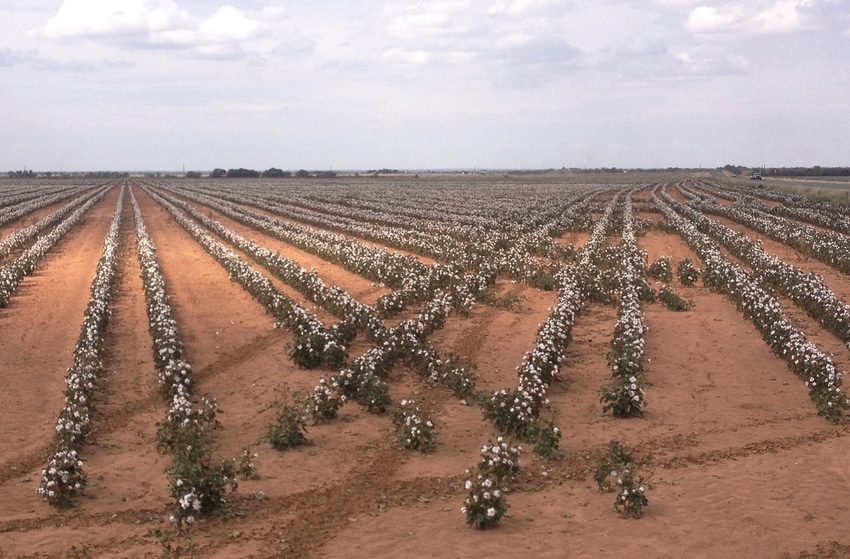
Statewide, Texas cotton production will be off about a half-million bales from last year’s 6.175 million. Acreage for harvest is down slightly, 4.5 million compared to 4.6 million last year. Planted acreage is also off, 4.8 million compared to 6.2 million last year, a drop likely resulting from spring rain that prevented timely planting as well as price concerns
October 20, 2015

Cotton production from the Texas Southern High Plains is estimated to top 3.35 million bales from 2.5 million harvested acres. Average yield is estimated to be 643 pounds per acre. Those production numbers top last year on fewer planted acres—2.69 million compared to 3.037 million in 2014.
The High Plains area—The Northern High Plains, Southern High Plains and the Northern Low Plains— will produce nearly 4.5 million of the state’s estimated 5.65 million-bale crop, according to the latest USDA Texas Cotton Production estimate. The Southern Low Plains will add another 425,000 bales.
Statewide, production will be off about a half-million bales from last year’s 6.175 million. Acreage for harvest is down slightly, 4.5 million compared to 4.6 million last year. Planted acreage is also off, 4.8 million compared to 6.2 million last year, a drop likely resulting from spring rain that prevented timely planting as well as price concerns.
For the latest on southwest agriculture, please check out Southwest Farm Press Daily and receive the latest news right to your inbox.
Considering the start the crop got, production looks pretty good, says Texas AgriLife Extension State Cotton Specialist Gaylon Morgan, College Station.
Morgan says warm fall weather helped cotton in the Rolling Plains and the High Plains catch up on maturity.
“Overall, from Haskell and Knox counties, and up to Wilbarger and Motley counties, dryland cotton is definitely going to make an above average crop,” Morgan said in a recent crop update compiled by Texas AgriLife media specialist Robert Burns.
Observations and conversations with producers at recent field days indicate at least an average crop in the Rolling and High Plains, Morgan said.
Good dryland crop
“I saw quite a bit of dryland cotton that would make about a bale per acre,” he said. “And irrigated cotton was looking pretty good too. Although the wet spring delayed planting, the full profile of soil moisture followed by June and early-July rains set a good yield potential. However, another rain in August would have made the good crop much better. The irrigated farmers did not really have to irrigate until late July and August, which was a big cost savings.” Farmers in the San Angelo area did not fare as well. Most dryland cotton was “burned up” due to missing multiple June and July rains, Morgan said.
“Considering the type of spring we had, with late planting, there was a lot of concern about cotton not being able to finish out,” Morgan said. “But this open fall with 90-plus degree temperatures and sufficient heat units allowed the crop to mature and open up, and we will hopefully be able to harvest this crop before the wet weather when the predicted El Niño arrives.”
Mark Kelley, Extension agronomist, Lubbock indicates the South Plains crop is promising. Warm fall temperatures helped mature that cotton. “We’re expecting three-quarters of a bale per acre on some of the dryland cotton and as much as two-plus bales on the highly irrigated cotton,” Morgan said.
Some South Plains dryland cotton missed timely rains and burned-up as it did in the Southern Rolling Plains. Rainfall was variable across the High Plains, and the exact number of acres lost to drought has yet to be determined.
“But it is safe to say that yields were certainly much reduced by the lack of rain late in the summer,” Morgan said. “There were good rains in June and July, but they really needed some more rain in August to finish out the dryland crop. The irrigated guys did pretty well because of the June and July rains; they were able to retain the fruit load through August with irrigation.”
South Texas and Blacklands
“Producers in the Rio Grande Valley were very pleased with their dryland and irrigated yields this year,” Morgan said. “It was a tough year getting cotton planted and harvested due to rain, but the yields were good. Moving up the coast, yields were highly variable depending on field drainage and planting date. Better-drained fields that survived the flooding conditions had some good yields.”
It was a different story for cotton in the Upper Gulf Coast and Blacklands, he said.
“The yields were below the five-year average. The excessively wet spring followed by no rain in July or August really hurt the yields. Harvesting ran over a month behind normal, and many farmers just wanted the 2015 season to be over.”
Planted acreage in the Lower Rio Grande Valley, at 58,000, was off significantly from last year’s 146,800. Average yield at 1,095 pounds per acre is slightly above last year’s 1,022. Production will decline from 309,000 to 130,000 bales.
Blacklands acreage also dropped significantly, 90,000 acres compared to 124,200 last year. Average yield, at 452 pounds per acre is off nearly 50 percent from last year’s 822 pounds. Production at 80,000 bales was off significantly from last year’s 210,600.
You May Also Like



